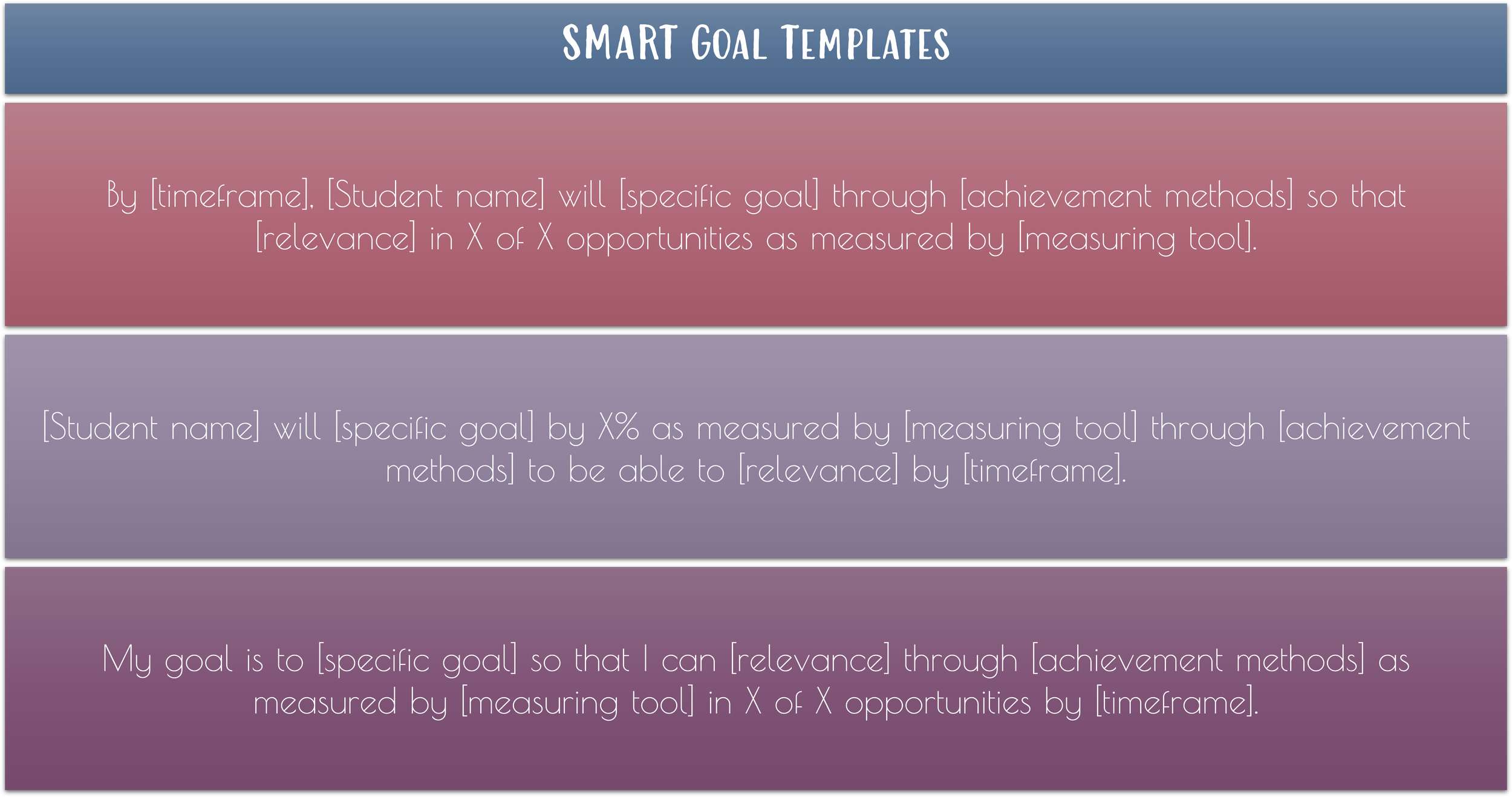How to Write a SMART Goal
Setting goals is an important part of personal and professional development. However, simply setting goals is not enough. Goals need to be well-defined, specific, and measurable to be effective. This is where the concept of SMART goals comes in.
The SMART acronym stands for Specific, Measurable, Achievable, Relevant, and Time-bound. In this blog post, we will explore what each letter of SMART stands for, when elementary teachers should use SMART goals for their students and for their own growth, and provide examples of SMART goals for teachers and students so that you and your students can have an amazing school year.
What is a SMART Goal?
A SMART goal is a goal that is Specific, Measurable, Achievable, Relevant, and Time-bound. These criteria help to create a clear and concise goal that is well-defined and can be easily tracked and measured. SMART goals are widely used in a variety of settings, including personal development, education, and professional development.
Each letter of SMART corresponds to a specific characteristic that a goal should have to be effective.
S – Specific
A goal should be specific and well-defined. This means that the goal should clearly state what you want to achieve and why it is important. Vague goals are hard to track, but a specific goal makes it easier to see the progress.
M – Measurable
A goal should be measurable so that progress can be tracked and evaluated. This means that there should be a clear way to measure success or progress towards the goal.
A – Achievable
A goal should be achievable, meaning that it is realistic and attainable. This means that it is possible to reach the goal given the available resources and time.
R – Relevant
A goal should be relevant to your overall objectives or mission. This means that the goal should align with your values, beliefs, and priorities.
T – Time-bound
A goal should have an end date or a specific timeframe for completion. This means that there is a clear endpoint or target date for the goal. This could be the end of the month, the end of the quarter, or the end of the school year.
When Should Elementary Teachers Use SMART Goals for Their Students?
SMART goals are particularly useful for elementary teachers as they can help to focus students on specific learning objectives and provide a way to measure progress towards those objectives.
SMART goals can be used for individual students or for the whole class. They can be used for a variety of subjects, including reading, writing, math, science, and social studies. SMART goals can be achieved in a month, a semester, or by the end of the school year.
It's a great idea to have students write their own goals because it teaches students about goal setting and increases buy-in when students are actively involved.
SMART goals are great to include in IEPs and 504s as well as ELL plans. Using this format makes it a lot easier to determine whether the accommodations students are receiving are working and whether instructors need to modify any existing supports.
Elementary teachers should use SMART goals for their students in the following situations:
To improve academic performance
SMART goals can be used to set academic targets for students. For example, a teacher might set a goal for a struggling reader to improve their reading fluency by a certain number of words per minute by the end of the school year.
To develop new skills
SMART goals can be used to help students develop new skills. For example, a teacher might set a goal for a student to master a particular math concept by a certain date.
To promote positive behavior
SMART goals can be used to promote positive behavior in the classroom. For example, one goal might be for a student to demonstrate kindness to others every day for a week.
To encourage student engagement
SMART goals can be used to encourage student engagement in the learning process. For example, a teacher might set a goal for a student to ask at least one question during each class.
Here is a list of topics to get you thinking about what achievable goal you can create for your students:
SMART Goal Topics
Classroom Participation
Clock Reading
Creative Writing
Grammar Skills
Handwriting
Homework Completion
Multiplication
Organization
Public Speaking
Reading Fluency
Social Skills
Spelling
Time Management
Using End Marks
Using Quotation Marks
Vocabulary
Examples of SMART Goals for Elementary Students
Here are some SMART goal examples that elementary teachers can use for their students:
Reading
Marcus will increase his reading fluency from 60 words per minute to 90 words per minute as measured by the DIBELS test through daily reading passages so that he can read on grade-level by the end of the school year,
Math
Dania will master the multiplication tables up to 12 as measured by a weekly timed quiz through math center practice 3 times a week so that she can decrease mistakes in her math work by the end of the month.
Writing
Emily will write a complete sentence with proper capitalization and punctuation on at least three out of four writing pieces through weekly small group writing instruction so that she can write clearer essays by the end of the spring semester.
Behavior
Julio will decrease disruptive blurting by 50% as measured by a daily behavior chart through hand raising and positive reinforcement so that he does not disrupt classroom learning by the start of Winter Break.
Engagement
Destiny will increase participation in classroom discussions by 25% according to a participation chart for each class period through positive reinforcement and check ins at the beginning of each class period so that she is more engaged during instruction by the end of the school year.
Template
To create your own teaching goals and to easily track student progress, follow one of these templates:
By [timeframe], [Student name] will [specific goal] through [achievement methods] so that [relevance] in X of X opportunities as measured by [measuring tool].
[Student name] will [specific goal] by X% as measured by [measuring tool] through [achievement methods] to be able to [relevance] by [timeframe].
My goal is to [specific goal] so that I can [relevance] through [achievement methods] as measured by [measuring tool] in X of X opportunities by [timeframe].
Teachers Setting SMART Goals
During a lot of my years in teaching, I was expected to create goals for myself. Sometimes this was done with the help of a mentor or during professional development. Other times, it was less formal.
Even though it was extra work on my part to think about my teaching skills, create a SMART goal, and work toward improving my teaching skills, it did make me better at my job.
It helped me recognize areas of weakness and create a plan to improve.
SMART goals for teachers can cover a lot of different topics and skills. If you're thinking about creating professional goals for yourself, but you're not sure where to start, read through this list to spark some ideas:
SMART Goal Topics
Classroom Community
Classroom Management
Classroom Organization
Classroom Procedures
Colleague Relationships
Differentiation
Facilitating Student Discussion
Giving Students Choices
Grading Student Work on Time
Lesson Engagement
Lesson Hooks
Lesson Plans
Organization
Small Groups
Student Relationships
Teaching Students with Autism
Work-Home Balance
Using Data
Using Rubrics
If the thought of creating a goal right now seems overwhelming to you or you're experiencing teacher burnout, consider making your goal about your own mental health or work-life balance instead.
SMART goals for teachers don't have to just be professional goals, personal goals are important too!
Teacher Smart Goals Examples
Here are a few examples of SMART goals for teachers. These SMART goal examples are broken up into the 5 different criteria so you can see exactly what that looks like, but you could rewrite them to match the student examples to be more succinct. (Or you can check out the FREE resource where I’ve already done that.)
SMART Goal Examples:
Parent Communication
Specific: Improve parent communication.
Measurable: Increase the frequency of communication with parents by sending a weekly newsletter and scheduling at least one parent-teacher conference per quarter.
Achievable: Establish a template for the weekly newsletter and set aside time each week to create it. Schedule conferences in advance and communicate with parents about the importance of attending.
Relevant: Positive communication with parents can improve student success and build trust between teachers and families.
Time-bound: Begin sending the newsletter and scheduling conferences at the start of the next quarter.
Growth Mindset
Specific: Develop a classroom culture that promotes growth mindset.
Measurable: Implement at least three activities or lessons that promote growth mindset and provide opportunities for students to reflect on their own learning and growth.
Achievable: Research and select relevant activities and lessons that align with the growth mindset philosophy.
Relevant: Encouraging a growth mindset can improve student motivation, persistence, and achievement.
Time-bound: Implement the new activities and lessons within the next month.
Grading
Specific: Improve assessment and grading practices.
Measurable: Implement at least two new assessment and grading practices that align with best practices and provide more accurate information about student learning.
Achievable: Research and select assessment and grading practices that align with best practices and the grade level and subject matter.
Relevant: Accurate and effective assessment and grading practices are essential for promoting student success and growth.
Time-bound: Implement the new practices within the next two months.
Lesson Hooks
Specific: Incorporate more lesson hooks into classroom instruction to facilitate greater interest and engagement from students.
Measurable: Implement at least two new lesson hooks per week, and track student involvement using a classroom observation rubric.
Achievable: Research and select lesson hooks that are appropriate for the grade level and subject matter, and plan them in advance. Incorporate the new lesson hooks into existing lessons or create new lessons.
Relevant: Incorporating lesson hooks can help engage and motivate students, leading to better retention of information and improved academic outcomes.
Time-bound: Implement the new lesson hooks starting from the beginning of the next school year and track progress using the observation rubric on a weekly basis.
Work-Life Balance
Specific: Achieve a better work-life balance by setting and maintaining clear boundaries between work and personal time.
Measurable: Spend at least two hours per day on personal activities, such as exercise or hobbies, and limit work-related activities to no more than eight hours per day.
Achievable: Prioritize personal activities and make a schedule that allows for both work and personal time. Set realistic goals for completing work-related tasks and avoid bringing work home.
Relevant: Achieving a better work-life balance can improve overall well-being and job satisfaction, leading to better performance in the classroom.
Time-bound: Begin implementing the new schedule and boundaries at the start of the next school year and track progress weekly.
Here are a few more examples of short term goals for becoming a great teacher.
More Examples:
"I will implement 15 minutes of responsive classroom twice a week where all students will have a chance to participate in partners or small groups by the end of March."
"I will give students 2-3 unique choices on 2 history assignments per week by the end of February."
"I will facilitate engagement from all students by drawing a name stick 15 out of 20 times that I call on a student before the end of the month.”
If you want more information about SMART goals, check out this article by Asana. Asana is a FREE task-management app that I’ve found really helpful for keeping track of my to-do list as I create my blogs.
Goal Not Met
If a student doesn't meet a SMART goal, it's important for the teacher to first evaluate the goal itself.
It's a good idea to have the timeline for most SMART goals end before the end of the school year so that you can adjust if the goal is not met.
The teacher should consider if the goal was realistic and achievable, and if the student had the necessary resources and support to meet the goal. If the goal was too challenging, it may need to be adjusted to make it more achievable.
Alternatively, if the goal was too easy, it may not have been motivating enough for the student to put in the necessary effort. The teacher should also consider if any external factors, such as home life or other personal issues, may have affected the student's ability to meet the goal.
Once the teacher has evaluated the goal, they should meet with the student to discuss their progress and provide feedback. The teacher should acknowledge the student's efforts and progress, even if the goal was not fully met. They should also provide specific feedback on what the student did well and what areas could be improved upon.
Together, the teacher and student can revise the goal if needed and create a new plan for moving forward. It's important for the teacher to continue to provide support and resources to help the student achieve the new goal, while also monitoring progress and adjusting as needed.
Goal Is Met
If you, your student, or your class meets their goal, take time to celebrate!
It takes hard work and dedication to achieve this kind of progress, so take the time to celebrate this achievement.
You may want to create a new goal to continue progress in the same area, or you might create a new goal in another area of weakness.
If you're worried about relapse on the goal, slowly take away the scaffolds and supports you were implementing, or keep them for the rest of the school year if they're what your student needs.
Better Than Yesterday
Whether your goal was for a student or for yourself, remember that success is about personal growth, not comparisons with other educators or other students.
If you became better at teaching than you were the day before, that's success!
If your student is just a little bit better at reading or engagement than they were before, it's worthy of celebration!
Make sure you don't get frustrated by comparing yourself to another educator or comparing a student to the other kids in your class.
Growth at any level is worth celebrating!
Conclusion
In conclusion, setting SMART goals is an effective approach for achieving measurable goals, both for students and teachers. By applying SMART criteria to teaching practices, elementary school teachers can set achievable goals that support their professional life and classroom organizations. This process not only benefits the current generation of students, but also has the potential to shape future generations.
Students work towards short-term goals as well as long-term goals that are aligned with the overall learning objectives, and they are encouraged to set SMART goals for themselves. In turn, teachers lead by example, setting their own goals to continuously improve their teaching practices and their self-perception as educators.
Setting SMART goals is equally important for both students and teachers. Teachers examples and strategies that are effective in setting SMART goals are essential to maximizing class time and ensuring that all learning objectives are met. Many teachers recognize that by setting SMART goals for themselves and for their students, they can make meaningful improvements in their practice, and create a more productive, engaged and successful learning environment.










